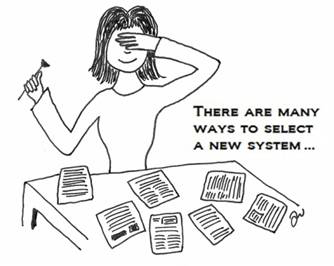INTRODUCTION
Selection of a new system or supplier can be crucial to your business, but it’s something that many organisations don’t do very often and so don’t have much experience in. This book provides a straightforward process to follow, which will guide you through selection and help you to choose wisely.
Of course, this is only one of a number of possible approaches. It’s worth focusing briefly on how this selection process differs from the formal procurement process usually followed by larger, and public sector, organisations. A formal procurement usually involves production of a very detailed specification, covering, in extreme clarity, exactly what the new system or supplier will need to do. This is a lengthy exercise! It also requires that you know in minute detail exactly what you want.
For small/medium organisations, it is often not practical to spend days, weeks or even months producing a complete specification followed by a formal tender. Additionally, for any organisation, there are occasions when you don’t yet know exactly what you need and want to see what’s on offer with a more open mind. The selection process outlined in this book asks potential suppliers for information about their system or service, based on high-level business requirements. This openness gives the supplier scope to be creative and innovative in their solution, which allows the selection team to consider a number of ways in which their need may be met. They can then choose accordingly.
With that in mind, let’s consider the context for this process – who would follow it, why it should be used, and when it should be started.
Who?
This process can be used by anyone, for any kind of selection. The primary audience for this book is expected to be those looking to select an IT system or service; the process is, however, fairly generic and can be easily adapted to any other kind of selection, such as choosing a new caterer or finding a new office location.
Why?
There are a number of reasons why a selection may be needed. Some examples are:
- Your organisation is growing and you need a more comprehensive finance system.
- An existing supplier is coming to the end of their contract and has not been performing well.
- Your IT kit is at the end of life and needs replacing.
- You want to have an IT system to replace a paper one.
- You want to concentrate on your core business and have a managed service for your Information and Communication Technology (ICT).
The process outlined here can be used for any of these and for many others.
But why follow a process at all? The main reason is that it increases your chances of a successful selection. By following standard steps, based on processes used successfully in other organisations, you avoid missing anything out and everyone can see what’s happening (and you can more easily learn lessons for your next selection).
Another key reason is that this process ensures that you follow a reasonable level of ‘due diligence’. There are many different definitions of this term, but a summary could be:
Performing reasonable research and analysis before committing to a business transaction to ensure that you do get what you think you will.
In the case of a selection, your shareholders, donors or other stakeholders in your business will want to be satisfied that you took reasonable steps to select the best candidate, in a fair and proper manner. The documentation produced as part of this process will aid you in proving your compliance with this demand.

When?
So, when should this book be used in the process? As early as possible! As soon as you have identified a need, then the selection process has started. In fact, it’s often the early steps that are the most important. Later on, in Chapter 2, you will read about an example of a case when issues came about because this was not done very well.
You don’t, however, need to follow every step in the process in full detail; you can tailor it to meet your specific circumstances. It’s best to use a ‘lightness of touch’ approach – consider each step and then perform it in as much detail as required. For example, when considering what assessment criteria to use, you may decide to weight each of the criteria out of five, or you may decide not to use weighting at all – but you should always have criteria.
